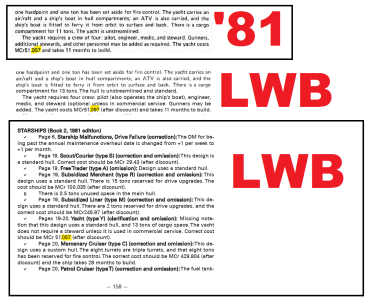pesco
SOC-9
Discovered several new items in Book 1 (facsimile edition), regarding combat:
The following need clarification, guidance appreciated:
See https://github.com/pesco/traveller-errata.
- p. 31: Second paragraph, sentence 7 (line 17): "Surprise continues until it is lost, and may thus continue indefinitely." (letter 'u' damaged in scan)
- p. 32: Line 6: "short [or] close"
- p. 32: Line 10: "option of the [referee]"
- p. 32: Line 11: "[on the] situation" (missing space)
- p. 32: Line 13: "c[o]ntact" (letter 'o' damaged in scan)
- p. 35: Section "Expertise", paragraph "Parrying": "A character may use his expertise level in his brawling or blade weapon [skill] as a negative DM..."
- p. 47: Range Matrix, row "Claws", column "Wound Inflicted" should be 2D. Next row should be "Teeth, +2, 0, no, no, no, 2D" (errata applied to wrong row).
The following need clarification, guidance appreciated:
- pp. 30, 33: The listing "Combat Procedure" on p. 30 does not state clearly whether all targets and attacks should be declared before any throws are made. The same applies to the paragraph "Basic Required Throw" on p. 33, second sentence: "He or she must then make a basic throw...". Is the word "then" here meant to imply that the throw is made immediately after the target is declared? This would give an advantage in that attacks could be declared based on knowledge of prior throws despite all attacks conceptually occuring at the same time.
- p. 33: First paragraph: In what order should the characters (player and non-player) state their movement status?
- p. 35: Section "Expertise", paragraph "Parrying": (a long gun) "is treated as a brawling weapon (a cudgel)". However, Cudgels are classified as polearms, not brawling weapons in section "Combat Equipment" on p. 37. Should the parenthesis on p. 35 be changed to "(a club)"? Otherwise it is unclear which skill to use (Brawling or Cudgel). NB, 1977 edition: "... uses the gun as a brawling weapon (as a club, for example)."
See https://github.com/pesco/traveller-errata.

